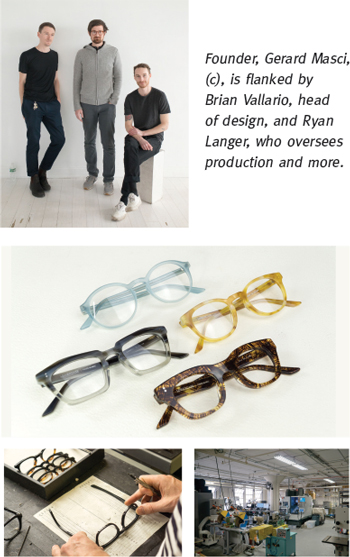RELATED CONTENT

NEW YORK—Lowercase NYC launched in Brooklyn’s Army Terminal in January 2017. But founder Gerard Masci’s path to eyewear actually started in 2015. He’d been working in the financial sector, as an investment analyst. But he was intrigued by the makers who were already working in the field, like Randolph and California’s Kala eyewear, and he started to research more. He literally also started to Google “how to” videos about framemaking, but then learning about materials, found Mazzuchelli and met with their representatives in downtown NYC not far from where he’d grown up.
“They were very supportive, introducing me to hinge makers, core wire suppliers and helped me find my first equipment supplier. I travelled to Varese, then Belluno and started to meet others. And, then, through a friend, was introduced to Brian Vallario, who was an architect and fabricator for architectural projects and he eventually became my partner and is our head designer.”
| |
|
| 
|
|
|
The two met at NY’s Marlton Hotel and 18 months later they launched their first collection, naming the first frame the Marlton in honor of that key meting. Masci recalled, “We searched for locations but learned more about the Brookyn Army Terminal. We had found other spaces, but we needed many amenities to where we’d set up, like concrete floors, freight elevators to manage the heavy power equipment, and other readily available industry resources that would enable us to start and we settled there. In the beginning it was just the two of us, initially at my dining room table, drawing and working on samples, then we started manufacturing our prototypes.” The pair also added another member to their team, Ryan Langer joined Lowercase soon after launch and oversees the more delicate parts of the production process. His background as a craftsman and experience in fabrication has taken the quality of the frames to another level, Masci related, and he also helps out a lot in terms of the firm’s web and social media presence.
Masci noted, “We were reimagining this process in the U.S. I was seeing a growing interest from the consumer about ‘story.’ Shinola was inspiring, how it was made in Detroit, what it was doing to bring back the craft of watchmaking. Micro breweries were burgeoning, there was just more engagement in localized products, there were many examples.”
Today, sales are managed by the partners. The team got some early coverage from the likes of the Wall Street Journal and also, interestingly, in the Japanese market where a small Tokyo retailer, Unsonian Goods Store, which curated unique clothing and accessories, discovered Lowercase. World spread in the independent optical channel, and Masci cited many early independent optical owners and supporters including Eyes on Fremont’s Nate Ogura “who have been with us from day one.”
Today Lowercase has expanded into new colors and shapes, and has built an inventory.
Masci welcomes the renewed interest in American eyewear makers. “I’m a big believer that at this stage, the more people pushing the idea of made local, quality manufacturing helps create a permanent niche in the market.”